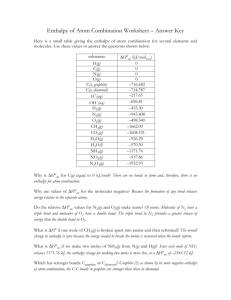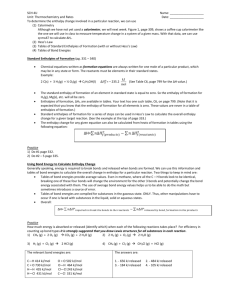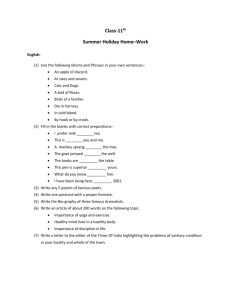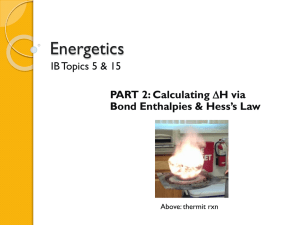notes-heat-2
advertisement
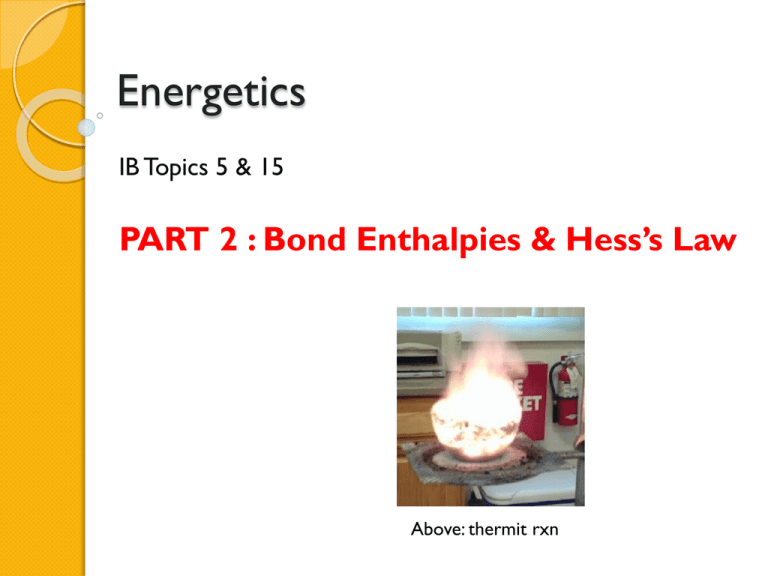
Energetics IB Topics 5 & 15 PART 2 : Bond Enthalpies & Hess’s Law Above: thermit rxn HESS’ LAW The value of H for a reaction is the same whether it occurs in one step or in a series of steps. H for the overall equation is the sum of the H’s for the individual equations. Hrxn = H1 + H2 + … Example: Calculate the enthalpy of reaction, Hrxn, for the formation of nitrogen monoxide from its elements N2 + O2 2NO Hrxn = ? Using these equations: 4NH3 + 3O2 2N2 + 6H2O H = -1530 kJ 4NH3 + 5O2 4NO + 6H2O H = -1170 kJ 2N2 + 6H2O 4NH3 + 3O2 H = +1530 kJ 2N2 + 2O2 4NO N2 + O2 2NO H = +360 kJ H =+180 kJ flip 2 HESS’ LAW Another way of thinking about Hess’ Law is graphically in terms of “energy cycles.” The enthalpy change for a reaction depends only on the difference between the enthalpy of the products and the enthalpy of the reactants. It is independent of the reaction pathway. HESS’ LAW The enthalpy change going from A to B is the same whether the reaction proceeds directly to A or whether it goes via an intermediate. A H1 B H2 C H3 H1 = H2 + H3 H3? =H1- H2 HESS’ LAW The enthalpy change going from A to B is the same whether the reaction proceeds directly to A or whether it goes via an intermediate. A H1 B H2 C H3 H1 = H2 + H3 H3? =H1- H2 HESS’ LAW with DIAGRAMS Let’s practice . HESS’ LAW For example, the enthalpy of combustion of both carbon and carbon monoxide to form carbon dioxide can easily be measured directly, but the combustion of carbon to carbon monoxide cannot. This can be represented by an energy cycle. C(s) + ½O2(g) -393 O2(g) kJ mol-1 CO2(g) Hx CO(g) ½O2(g) -283 kJ mol-1 -393 = Hx + (-283) Hx = -393 + 283 = -110 kJ mol-1 Example: Calculate the standard enthalpy change when one mole of methane is formed from its elements in their standard states. The standard enthalpies of combustion (Hc ) of carbon, hydrogen and methane are -393, -286 and -890 kJ mol-1 respectively. Step 1: Write the equation for enthalpy change with the unknown H value. Call this value Hx. C(s) + 2H2(g) Hf CH4(g) Example: Calculate the standard enthalpy change when one mole of methane is formed from its elements in their standard states. The standard enthalpies of combustion ( Hc) of carbon, hydrogen and methane are -393, -286 and -890 kJ mol-1 respectively. Step 2: Construct an energy cycle showing the different routes to the products (in this case the products of combustion). C(s) + O2(g) CO2(g) + 2H2(g) O2(g) 2H2O(g) Hf CH4(g) 2O2(g) Example: Calculate the standard enthalpy change when one mole of methane is formed from its elements in their standard states. The standard enthalpies of combustion ( Hc) of carbon, hydrogen and methane are -393, -286 and -890 kJ mol-1 respectively. Step 3: Use Hess’ Law to equate the energy changes for the two different routes. C(s) + O2(g) CO2(g) + 2H2(g) O2(g) Hf CH4(g) 2O2(g) 2H2O(g) Hc (C) 2Hc (H2 ) Hx Hc (CH4 ) direct route route via methane Example: Calculate the standard enthalpy change when one mole of methane is formed from its elements in their standard states. The standard enthalpies of combustion (Hc ) of carbon, hydrogen and methane are -393, -286 and -890 kJ mol-1 respectively. Step 4: Rearrange the equation and substitute values to solve for the unknown H value. c c x H (C) 2H (H2 ) H c H (CH4 ) Hx Hc (C) 2Hc (H2 ) Hc (CH4 ) Hx 393 2(-286) - (-890) Hx 75 kJ mol -1 STANDARD ENTHALPY CHANGE OF FORMATION, H f data booklet 12 Definition: the enthalpy change when one mole of the compound is formed from its elements in their standard states at 298 K and 1 atm of pressure. ◦ Note: it follows that the ∆Hf for an element in its standard state will be zero. 0 0 H2(g) + ½O2(g) → H2O(l) ∆Hrxn=? ∆Hrxn = ∆Hf (H2O) = -285.8 kJ mol-1 What is the standard state of carbon ? solid What is the standard state of oxygen ? gas What is the standard state of silver ? solid Using standard enthalpy of formation ΔH reaction = ΔHf products - ΔH f reactants STANDARD ENTHALPY CHANGE OF COMBUSION, Hc Data booklet 13 Definition: the enthalpy change when one mole of a substance is completely combusted in oxygen under standard conditions. Example: An accurate value for the standard enthalpy change of formation of ethanol can be determined from the cycle below. 2C(s) + 3H2(g) + ½O2(g) 2O2(g) 3/2 O2(g) 2 H (CO2 ) 3 H (H2O) f 2CO2(g) + f 3H2O(g) ? By Hess' Law: ? Hf (C 2H5OH) C2H5OH(l) 3O2(g) Hc (C 2H5OH) ? ? 2DH f (CO2 ) + 3DH f (H 2O) = DH f (C2 H 5OH) + DH c (C2 H 5OH) 2(-393.5) 3(285.8) Hf (C 2H5OH) (1371) Hf (C 2H5OH) 273.4 kJ mol -1 BOND ENTHALPIES data booklet 11 Enthalpy change (H) can also be calculated directly from bond enthalpies. Bond enthalpy for a diatomic molecule is defined as the enthalpy change for the following process: X-Y(g) ↔ X(g) + Y(g) BOND ENTHALPIES Breaking bonds: H = positive (endothermic) Forming bonds: H = negative (exothermic) Calculating H from bond enthalpies: Hrxn = (bonds broken) - (bonds formed) Single Bonds H-H 436 C-C 348 C-H 412 O-H 463 N-H 388 N-N 163 Double Bonds C=C 612 O=O 496 (g) Triple Bonds C≡C 837 N≡N 944 + Example: Calculate H for the hydrogenation of ethane (g) HH (g) Energy absorbed to break bonds: Energy released as bonds form: C=C 612 4 C-H 4 x 412 H-H 436 C-C -348 6 C-H - 6 x 412 2696 kJ There is more energy released than absorbed, so the rxn is exothermic. H = 2696 – 2820 = -124 kJ mol-1 -2820 kJ Single Bonds H-H 436 C-C 348 C-H 412 O-H 463 N-H 388 N-N 163 Double Bonds C=C 612 O=O 496 Triple Bonds C≡C 837 N≡N 944 Example: Calculate H for the combustion of hydrazine in oxygen. This reaction has been used to power spacecraft. (g) + O=O (g) N≡N (g) + 2 (g) Energy absorbed to break bonds: Energy released as bonds form: N-N 163 4 N-H 4 x 388 O=O 496 N≡N 944 4 O-H 4 x 463 2211 kJ There is more energy released than absorbed, so the rxn is exothermic. H = 2211 – 2796 = -585 kJ mol-1 2796 kJ OMIT Limitations of Using Average Bond Enthalpies Average bond enthalpies can only be used if all reactants and products are gases. ◦ If the H2O product in the previous example were a liquid, then even more heat would be evolved since the Hvap for H2O would also need to be included in the calculation. Average bond enthalpies are obtained by considering a number of similar compounds, but in reality the energy of a particular bond will vary slightly in different compounds (it will be affected by neighboring atoms). Thus, H values obtained using average bond enthalpies are not necessarily very accurate. WORTH TO LOOK AT : DATA BOOKLET # 10 AND 11 # 10 = COVALENT BOND LENGTH # 11 = AVERAGE BOND ENTHALPIES WHAT IS THE Br- Br bond length ? Cl- Cl bond length? 199 x 10-12 m 228 X 10-12 m WHAT IS THE Br- Br bond enthalpy ? Cl- Cl bond enthalpy? 193 kJ/mol Which bond is stronger? Why is the Cl-Cl bond shorter? 242 kJ/mol Explain Ozone Depletion FREE RADICAL λ<330 nm DEPLETION The level of O3 in the atmosphere stays at a constant level if the rate of formation is balanced by the rate of removal Which step(s) is (are) exothermic ? Which step requires more energy : the breaking of the double bond in O2 or in O3 ? Ozone O3 6e- x 3 = 18 e- oxygen O2 6e- x 2 = 12 e- 1.21 A Longer bond: weaker Shorter bond: stronger Question: Use section 11 of the IB data booklet to calculate the minimum wavelength of radiation needed to break the O=O double bond in O2 O=O bond enthalpy = + 498 kJ / mol = + 498,000 J / 6.02 x 1023 bonds Energy photon needed to break one bond = E photon= 498,000 ÷ 6.02 x 1023 =8.27 x 10-19 J c = λν E photon = hν λ=c/ν ν =E photon / h λ = c . h / Ephoton λ = 3.00 x 108 ms-1 x 6.63 x 10-34 Js / 8.27x10-19 = 2.41x10-7 m = 241 nm ( 241 x 10-9 m )


